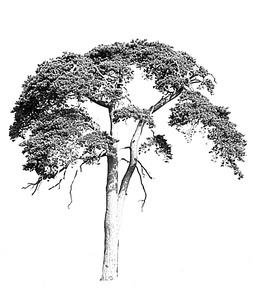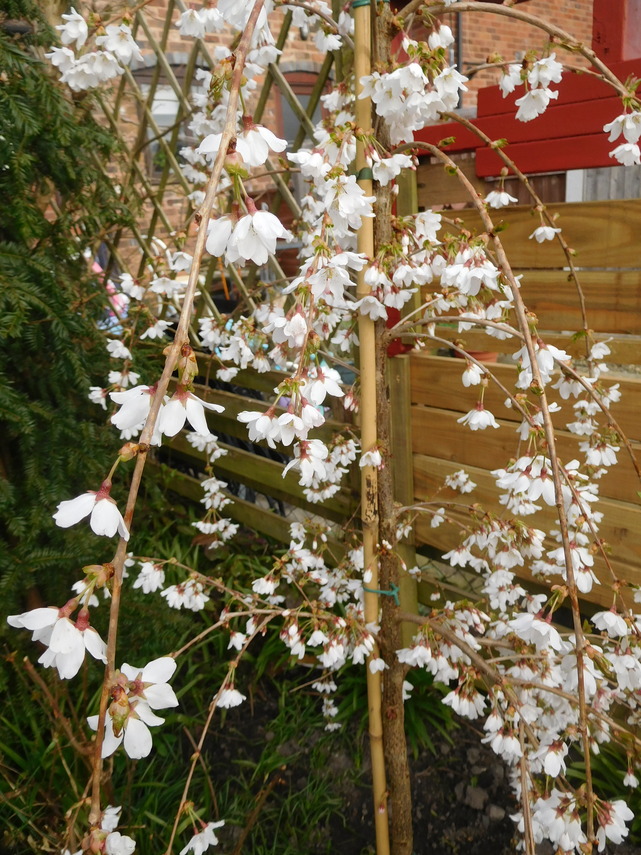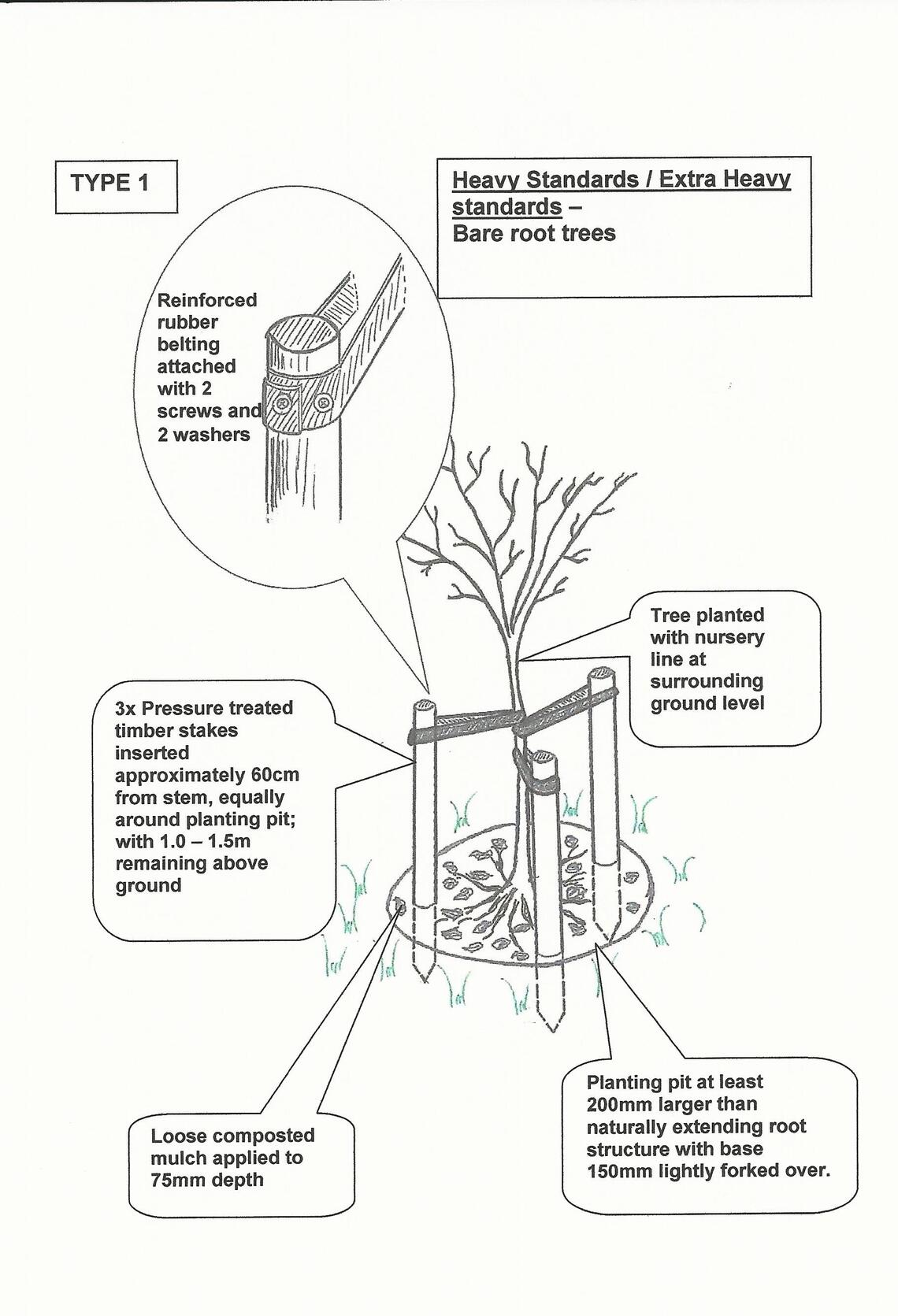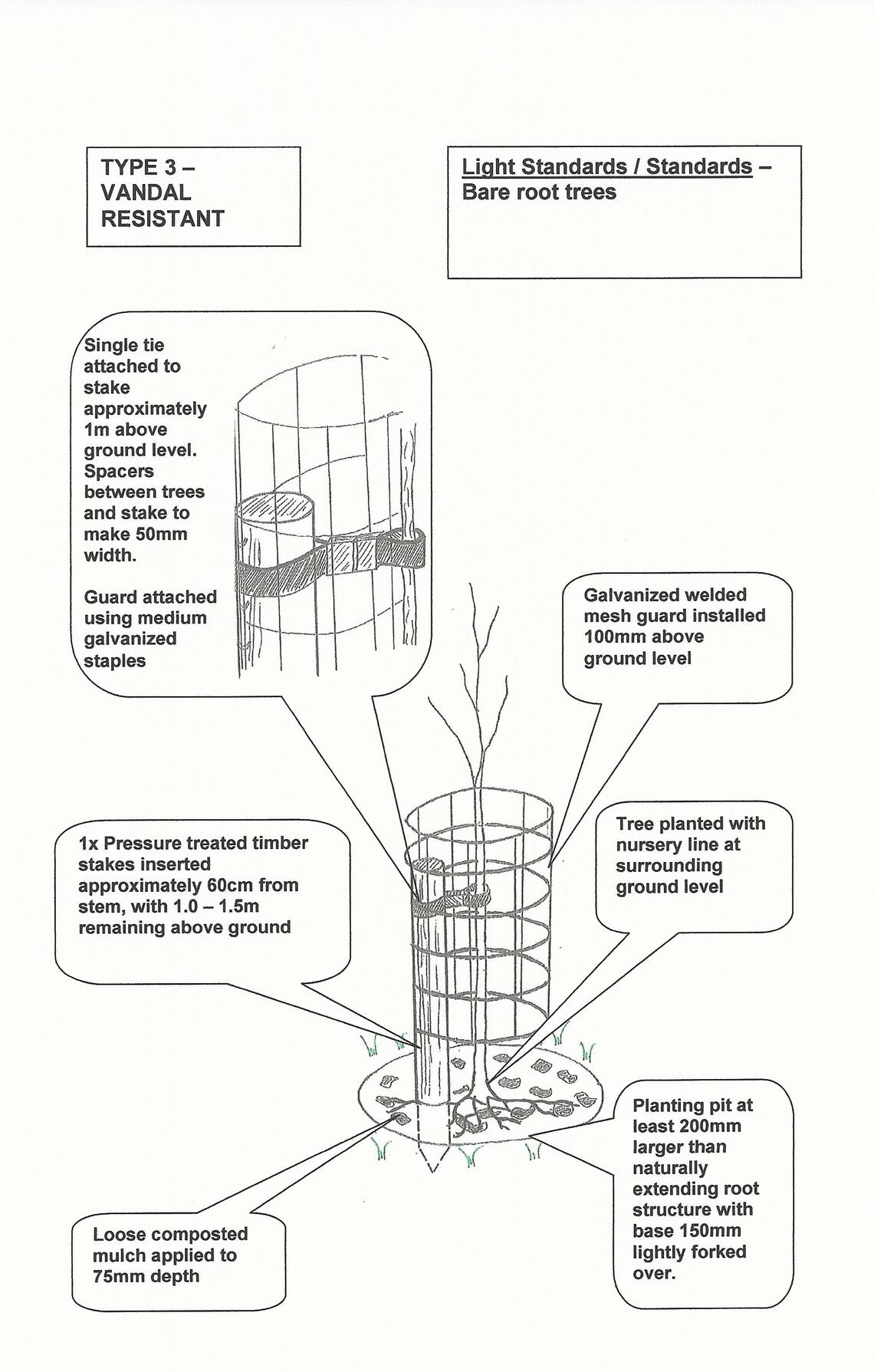Tree of the season.
How to plant a tree and species suggestions.
Spring
Scroll further down this page to find out how to choose the right live tree for Christmas, suggestions for evergreen and deciduous trees and how to take cuttings.
Choosing the right tree
When planting a tree it is most important to choose the right tree for the location in which you wish to plant to get the best out of your tree and avoid problems for the future. When buying a tree from a nursery always check that the tree has been grown in this country and is not imported. Ask for the expert advice which should be on hand and describe in detail where you wish to plant the tree. It is important that you do not plant a tree which will grow too large and will over time cause problems for your self or your neighbours. Check the height and spread of the tree in maturity, also check that roots will not enter drains or are too close to buildings or walls. Trees can beautify and add structure to a garden, they will attract and shelter birds and some species will attract bees and insect pollinators, think about how you would like trees to perform for you, would you like to see catkins and blossoms in the spring, colour and fruits in the autumn or evergreen.?
The right tree in the right place will give endless pleasure simply by being in your garden.
Evergreen trees.
Here are a few suggestions for evergreen trees. Many evergreens are only hardy to -5C so choose wisely for north of the River Severn.
Magnolia Grandiflora: Bold, shiny leaves, russet on the underisde with huge flowers in summer. Up to 15ft in 20 years and hardy to -15C
Arbutus unedo: Pleasing foliage in wintertime and flowers and berries later. Eventually 33ft tall hardy to 15C
Ilex x koehneana: Quick growing holly abundant in berries but needs male plant for pollination. Up to 33ft hardy to -15C
Ligustrum lucidum: Related to the privet, colourful leaves in Autumn and sprays of flowers in Spring. Up to 26ft hardy to -15C.
Olea europaea: The Mediterranean olive, tender -5 to -10C so needs protection in the winter further north. Grow on as a young tree to avoid imports if possible. Consider the Chilean Myrtle instead.
Deciduous trees
All of the following trees are hardy to -20C and are chosen because they provide beautiful silhouette branch tracery in winter.
Cornus alternifolia: Grows up to 10ft
Betula pendula: Weeping birch. Grows up to 15ft
Rhus typhina: Grows up to 16ft but has broad spread
Corylus avellana contorta: Hazel, grows to 16ft
Metasequoia: Dawn redwood, grows to 100ft eventually. Needs very large open space.
Fagus sylvatica Pendula: Very large weeping beech. Grows to 56ft high and wide, needs very large open space.
Carpinus betulus Fastigiata: Pyramid shaped hornbeam. Grows to 30ft high and wide, needs very large open space
How to Plant a Tree
The Much Wenlock Tree Forum acknowledges both David Woodhouse (previously Arboricultural Officer, Shropshire Council) and Webster, The Garden, Royal Horticultural Society, January 2018 for the following advice;
Traditionally trees are planted during their dormant season between November and March, but container grown trees can be planted at anytime.
A round hole may be dug on lighter soils but on heavier soils it is better to dig a square hole, roots can find corners to break out of square holes but in clay can girdle in a round hole. Make the hole three times the width of the roots and spike the bottom and the sides of the hole to encourage drainage.
Position the tree so that the top of the roots is just below the surface of the soil, check the depth by offering the tree into the hole first before back filling.
The tree should be supported by stakes to a third of its height or with an angled stake so that it is fully supported at the base but can move freely at the top branches - this helps trigger anchor roots to grow
- Tree support
Metal grills and guards are highly expensive and require removal relatively quickly as the tree grows to come into contact with them. As such the draft design shows trees supported by 3x tantalised timber stakes and loops of rubber strapping. It is much cheaper, easy to install and remove and provides a good level of protection but allows trees to stabilise very quickly.
- Tree size
Tree sizes can be heavy standard 10-12cm girth and above, or light standard with a smaller girth.
The trees should meet the criteria set out by the Horticultural Trade Association for trees and shrubs
The trees should preferably be container grown. Other rooted forms of tree such as bare-root (no soil on the roots) or rootball (a scoop of soil and some of the roots) are considered less reliable and more vulnerable to failure through poor nursery extraction and / or subsequent handling. It is however, possible to obtain high quality trees in these forms from some nurseries.
- Watering
When planting any new tree it is extremely important to ensure that it is adequately watered during the summer months for at least the first two years. This is because the tree will have had only a limited chance to put down new roots into the surrounding area from which to absorb water. Creating a ‘dish’ of soil around the base of the tree will help prevent water from running off away from the tree.
- Standards – Watering of such trees is very important. Weekly watering during the drier summer months is really important. Water should be applied to the planting pit and should consist of approx 20 litres (5 gallons) of water applied to each tree in such a way that the water is able to percolate through the soil, avoiding any run-off. The frequency of watering should be at least every 14 days during dry periods.
- Mulching
To aid establishment and to also help maintain tree help it is important to ensure that after the tree has been planted an application of well-rotted woodchip mulch should be applied to the surface of the planting pit / area to a diameter of at least 1m in diameter and to a depth of 75mm. Care must be taken to not pile mulch against the bark of the newly planted tree. As time goes by this mulch will work its way into the soil and will help the tree resist drought and other impacts. This will however need topping up annually for at least the first 5 years. It is important that the mulch is not piled against the tree stem as this can cause the degradation of the tree bark and can lead to premature tree failure in the medium term.
Types of mulch
- Well-rotted compost – This can include a variety of materials usually mixed together. Commonly composted garden waste is used as it is the bi-product of the waste collection industry. Can sometimes contain Lime, which on a few trees can be problematic, but usually it is of benefit. Usually contains naturally occurring beneficial fungi (Mychrorriza) that help trees establish. This should be peat-free in nature.
- Well-rotted woodchip – This is a bi-product of the tree surgery industry and consists of woodchip and leaves that have been partially composted (at least 6 months). Very durable mulch, lasts well and encourages beneficial fungi (Mychrorriza) to grow.
Choosing a Tree for Christmas
Do you plant a real Christmas tree at this time of year ? Or do you have an artificial one ? It's quite right to think “artificial” if you're environmentally conscious even though real Christmas trees are grown in large numbers and replaced when sold. It still takes many years for them to grow to a reasonable height before selling again. But you can still buy “real” and still be environmentally aware. Think of buying a Christmas tree with roots and planting it in your garden when the celebrations are over. I did this for about 20 years and it worked well but I used two trees. After the first Christmas, I planted my tree in the garden but bought a second one for the following season. Once Christmas was again over, I planted this one too. On the third Christmas, I dug up the first tree and used it in the house, replanting it afterwards to use the second tree the season after. I found that this worked very well because it gave each tree time to recover from the stresses of using it in a warm indoors and, because of the disruptions in its life, it was thwarted in its growth. So neither tree shot off to become too tall and both were kept reasonably house-sized. Obviously, there comes a time when the trees will become too tall, but perhaps that's the time to start again.
So what real trees might we plant for Christmas ?
Norway Spruce (Picea abies)
This is the tree that Prince Albert brought from Germany and has become our traditional Christmas tree. It has a lovely strong resin scent but its needles are rather spiky and do tend to drop all over your floor. It has dense branches which are an asset but you do need to spray it with water occasionally to reduce needle drop, not something I'm keen on doing too frequently indoors. This, by the way, is Europe's tallest native tree species, but if you buy a rooted specimen you could control its height by the method I give above.
Fraser Fir (Abies fraseri)
This tree is traditional to American Christmases and the species planted in the White House. However, it is readily available over here, is elegantly symmetrical, beautifully scented and has good needle retention. The needles are dark blue/green so it looks attractive too. However, there is one downside to it in that it may not survive if its roots are cut. So buy one in a pot that can be easily transferred to your Christmas tree container without cutting and, if you plant this in your garden after Christmas, be careful in a subsequent year if you have to do some minor pruning to the roots to re-establish it in the house.
Nordmann Fir (Abies nordmanniana)
This species has a good symmetrical shape with glossy dark blue/green needles. It is hardy, with “soft to the touch” needles and has good needle retention. Sounds like the ideal tree ! But this, too, has one downside. It can be more expensive.
Colorado Blue Spruce (Picea pungens)
This is the traditional Christmas tree in Germany these days. It has a wonderful aroma, attractive silver/blue foliage enhanced by ridged branches. It is, however, rather more prickly than other species. If you were thinking of buying this beautiful tree, try to find one of its two varieties: “Koster” or “Moerheim”. These accentuate its blue colour and are now just grown as Christmas trees.
Serbian Spruce (Picea omorika)
This species has a strong fresh scent and is bushier and slimmer than others, useful if your room has less space (or less space in the garden to plant afterwards). Its needles are dark blue/green above and blue/white beneath.
Korean Fir (Abies koreana)
This is an unlikely species to plant at Christmas but if you want something a little different, here is a good choice. It has shortish dark green slightly curling needles and excellent needle retention. If you plant this in your garden afterwards, watch for the attractive purple cones.
Sussex Fir ( or Canaan Fir, a variety of Balsam Fir)
This is a very rare and unusual choice for a Christmas tree but if you want something that's different ! It is possibly a hybrid between Balsam and Fraser Firs. It has soft needles, the pine is scented with orange so it has that enhancing and all-pervading citrusy smell and good needle retention. Very common in America, sorry to say suppliers over here are few but there are some if you look on-line. If any of our readers track down a specimen of this tree, please let me know what you think of it.
So there you are.....
If you want a recommendation, I would say pay that little bit extra for a Nordmann Fir. It's worth it. (But I have to say I would be tempted by the Colorado Blue Spruce.) I live in Homer and we are eventually having our telephone box removed. We have been kindly donated a Nordmann Fir by a local resident and shall be planting that in place of the telephone with a plan to get the children of the village to decorate it each year.
John Tuer (727642)
. Raising trees from hardwood cuttings
Trees are expensive so why not try raising your own. Cuttings can be taken from mid autumn to late winter. Using the current seasons growth works best. Cut shoots into sections 10-20 cm or 4-8 inches with about four buds. Make a horizontal cut below a node at the base of each cutting and a sloping cut away from a bud at the top. Dip each cutting into rooting gell and insert cuttings into a 6 inch pot of loam based compost with grit. Place in a cold frame or unheated greenhouse. The process is the same for evergreen or deciduous.
Taken from the December 2017 issue of The Garden RHS



